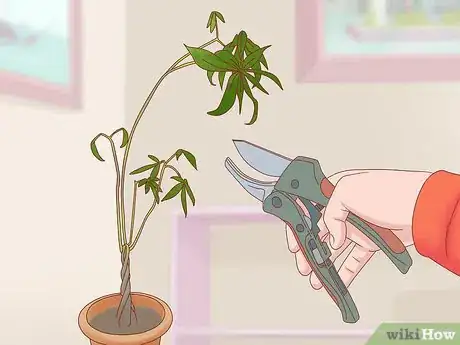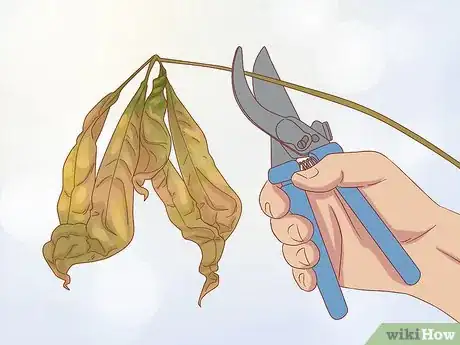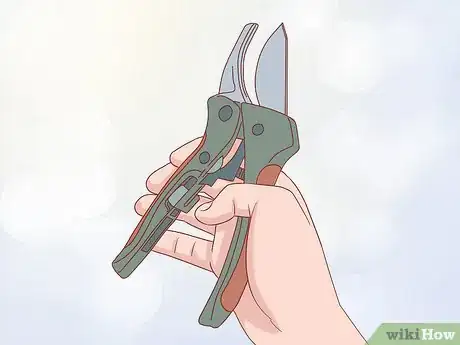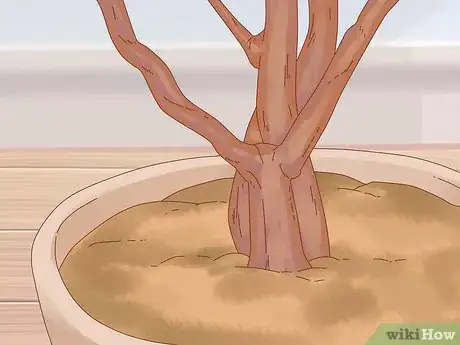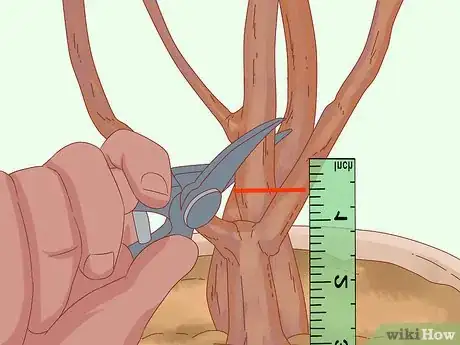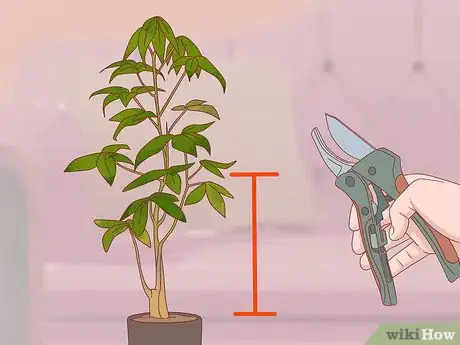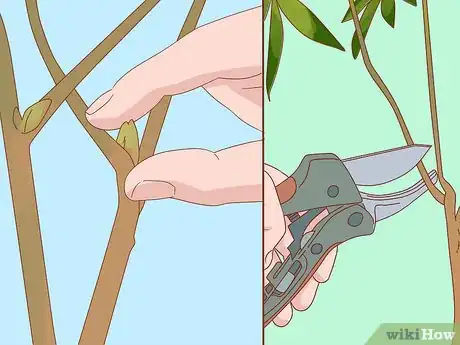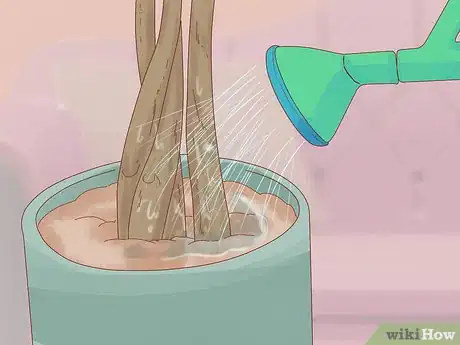This article was co-authored by Chai Saechao. Chai Saechao is the Founder and Owner of Plant Therapy, an indoor-plant store founded in 2018 based in San Francisco, California. As a self-described plant doctor, he believes in the therapeutic power of plants, hoping to keep sharing his love of plants with anyone willing to listen and learn.
wikiHow marks an article as reader-approved once it receives enough positive feedback. In this case, 95% of readers who voted found the article helpful, earning it our reader-approved status.
This article has been viewed 367,379 times.
A money tree, also known as a “Good Luck Tree,” is a plant that is said to bring positive energy to a space and thought to be good luck for money. Money trees are popular because they require very little effort to maintain.[1] It has a thick, often braided, stem, large green leaves, and can grow up to 10 feet (3.0 m) tall. Pruning your money tree will ensure it does not become overgrown and maintains a nice shape. Start by deciding when it is time to prune your plant and then use sharp gardening shears to trim it. Make sure you pinch and trim the tree regularly so it stays healthy and grows beautifully.
Steps
Deciding When to Prune
-
1Prune the tree if it becomes overgrown. Money trees should be pruned if they start to grow too tall or wide for their pots. You may notice branches or leaves extending out from the top or sides of the tree. This means it’s time to prune the tree to reshape it and encourage healthy growth.[2]
-
2Remove brown or wilted leaves with pruning. Dry, brown leaves may be an indication that the air is too dry or cold around the tree. The tree may also not be getting enough natural light.[3]Advertisement
-
3Do a regular pruning in the spring. Money trees maintain their shape best if they are pruned at least once in the springtime. Make it a point to prune your tree at least once in the months of March to May so it can flourish for the rest of the year.[4]
Pruning the Tree
-
1Use sharp gardening shears. Look for gardening shears at your local gardening supply store or online. The shears should be clean and sharp so you can trim the tree properly.[5]
- Do not use shears that have already been used on plants that have any diseases or pests, as they can then transfer to the tree. Clean the shears with water or use a different pair of shears just for the money tree.
-
2Find two branches that form a V-shape off the trunk. Look for two branches that extend out from the trunk of the tree to form a V-shape. Place your finger above the V-shape to mark it so you know where to cut.[6]
- Pruning the tree at the V-shape will ensure the tree maintains its shape and growth.
-
3Cut the trunk 1⁄2 inch (1.3 cm) above the V-shaped branches. Hold the gardening shears at a 45 degree angle as you cut the trunk. Make a clean cut to remove excess branches and leaves.[7]
-
4Remove branches on the top and sides of the tree. Work your way around the tree, cutting branches off the top and sides of the tree that appear overgrown. Make sure you cut 1⁄2 inch (1.3 cm) above V-shaped branches on the trunk of the tree.
-
5Prune off any branches with dry or brown leaves. If you notice the tree has dead, dry, or brown leaves, trim the off by cutting them off at the stem at a 45 degree angle. Make sure you leave at least 1⁄2 inch (1.3 cm) of growth on the stem so it can grow back fuller and healthier.
-
6Trim the tree down to no more than half its size. Err on the side of caution and trim the tree a little at a time. Remove a few overgrown branches and any brown leaves. Then, step back and look over the shape of the tree. If the tree still looks uneven in shape, trim off more branches until it looks more uniform.[8]
- Do not remove too many branches or leaves, as this can stunt the growth of the tree. Remove a little at a time, rather than a lot of the tree at once.
Maintaining the Tree
-
1Pinch and trim the tree regularly to prevent overgrowth. If you notice new buds are forming on the branches of the trees, use your thumb and forefinger to pinch them slightly so they grow well. You can also remove any overgrown branches with gardening shears to keep the tree in check and encourage healthy growth.[9]
-
2Water the tree’s roots when the soil is dry to the touch. Use a watering can or jug with a long neck to get to the roots of the plant, as getting water on the stem or leaves can cause rot and attract pests to the tree. Only water the tree’s roots when the soil feels dry, as you do not want to overwater the tree.[10]
- Water the tree less during the winter months so it does not develop root rot.
-
3Repot the tree every 2-3 years. If you notice the tree’s root system has filled the pot, you may need to repot the tree. Time the repotting for the mid-summer months. Remove the tree and the soil from the pot. Use clean gardening shears to prune back 1/4 of the roots. Then, place the tree in a new pot with drainage holes or gravel and fresh soil.[11]
- Water the money tree well after you repot it to encourage growth. You can submerge the entire pot in a tub of water or use a watering can to water the roots well.
Expert Q&A
Did you know you can get expert answers for this article?
Unlock expert answers by supporting wikiHow
-
QuestionWhen should money trees be pruned?
 Chai SaechaoChai Saechao is the Founder and Owner of Plant Therapy, an indoor-plant store founded in 2018 based in San Francisco, California. As a self-described plant doctor, he believes in the therapeutic power of plants, hoping to keep sharing his love of plants with anyone willing to listen and learn.
Chai SaechaoChai Saechao is the Founder and Owner of Plant Therapy, an indoor-plant store founded in 2018 based in San Francisco, California. As a self-described plant doctor, he believes in the therapeutic power of plants, hoping to keep sharing his love of plants with anyone willing to listen and learn.
Plant Specialist
-
QuestionIs it okay to trim a stalk back to the point where no leaves remain? Will it regrow?
 Susan ButlerCommunity AnswerIt is easier to trim the plant all at once. If you are trying to get a stem to grow in a specific direction, be mindful of how you prune it. New growth tends to form along prune cuts, so the direction the 45-degree angled cut is facing is important. To make a new stem grow up, place the angled cut on top of the stem.
Susan ButlerCommunity AnswerIt is easier to trim the plant all at once. If you are trying to get a stem to grow in a specific direction, be mindful of how you prune it. New growth tends to form along prune cuts, so the direction the 45-degree angled cut is facing is important. To make a new stem grow up, place the angled cut on top of the stem.
References
- ↑ Chai Saechao. Plant Specialist. Expert Interview. 20 February 2020.
- ↑ Chai Saechao. Plant Specialist. Expert Interview. 20 February 2020.
- ↑ http://www.guide-to-houseplants.com/money-tree-plant.html
- ↑ http://www.guide-to-houseplants.com/money-tree-plant.html
- ↑ http://www.guide-to-houseplants.com/money-tree-plant.html
- ↑ https://www.youtube.com/watch?v=_MqVkcGcf38&feature=youtu.be&t=26
- ↑ https://www.youtube.com/watch?v=_MqVkcGcf38&feature=youtu.be&t=31
- ↑ http://www.guide-to-houseplants.com/money-tree-plant.html
- ↑ http://www.guide-to-houseplants.com/money-tree-plant.html
- ↑ Chai Saechao. Plant Specialist. Personal interview. 20 February 2020.
- ↑ https://www.ourhouseplants.com/plants/jade-plant
About This Article
If you need to prune a money tree, it's best to do it once in the spring unless it becomes overgrown or out of control before that time. When you're ready to prune, grab a sharp pair of clean gardening shears. Next, look for two branches that extend out from the trunk of the tree in a V-shape. Once you find the spot, hold the shears at a 45 degree angle and cut the trunk 1⁄2 inch above the V-shaped branches. Be sure to make a clean cut to remove excess branches and leaves! Then, working your way around the tree, cut overgrown branches off the top and sides, always cutting 1⁄2 inch above V-shaped branches on the tree trunk. Finally, remove any branches with dry or brown leaves to stimulate healthy new growth. For tips on how to avoid over-pruning your money tree, read on!

